Do you want your content to work towards your business goals? Then, it’s time to have a social media engagement talk.
It’s nearly impossible to overestimate the importance of engagement when the market is flooded with social media content. Engagement means people took the time and effort to stop and like, comment on, or share your content on a social media platform, signaling both the algorithm and you that this post is working.
Growing your audience, getting more visibility, boosting conversions — engagement is the key to practically everything you do on social media.
Social media analytics play a crucial role in this process. To boost social media engagement, you need to analyze your social media metrics, develop engaging content, and respond to customer interactions effectively.
In this article, I’ll cover 11 strategies on how to increase social media engagement and establish strong organic positions on social media platforms.
Let’s roll!
How to increase social media engagement in 2024
What is social media engagement?
Why is social media engagement important?
11 ways to boost your social media engagement
How do you measure the impact of your social media engagement?
FAQs about social media engagement
What is social media engagement?
Social media engagement is a key social media metric that measures the interaction level of the social media audiences with a piece of content produced.
It’s not only about how many likes or shares you get — it’s about whether your audience is really connecting with you and whether the content you’re sharing is hitting the right chord.
Measuring engagement involves analyzing social media interaction, involvement, and responsiveness across various social media sites.
Engagement is typically calculated by tracking all interactions on a post or account. This leads us to two different types of engagement: post-level engagement and account-level engagement.
Post engagement usually concentrates on likes, shares, and comments.
Account engagement can also include direct messages, website visits, follows, mentions, and more.
Social media analytics tools aggregate these interactions to provide an engagement rate, usually expressed as a percentage.
Each action represents a different level of user interest and interaction. For instance, a comment or a share usually indicates higher engagement than a like because they require more effort from the user and often signify deeper involvement with the content.
However, there is no bad or good engagement — some actions are just more valuable to a particular social media platform’s algorithm.
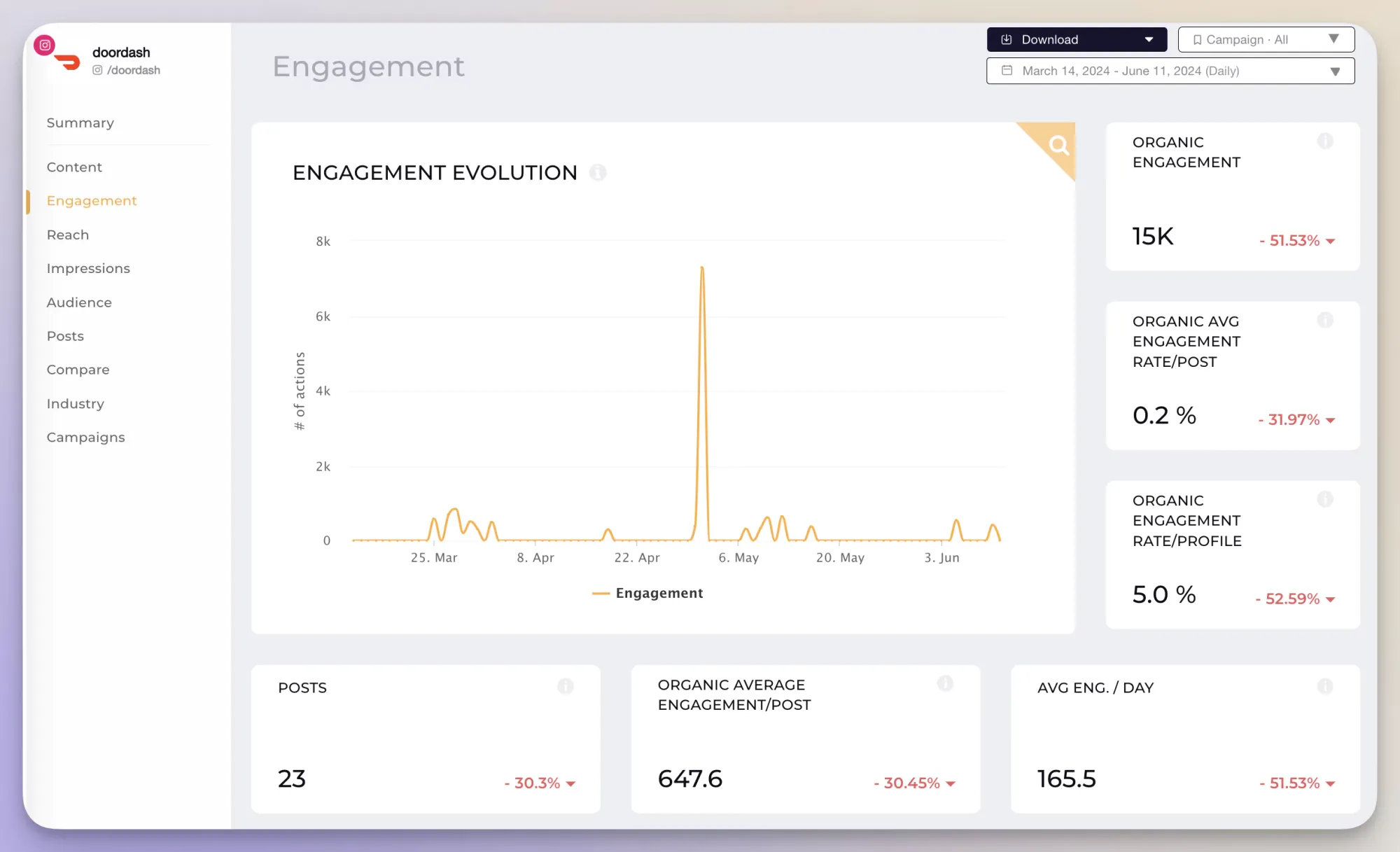
Analyze your engagement metrics
Get your top social media metrics and access historical post data with Socialinsider!
Why is social media engagement important?
Engagement on social media plays a crucial role. Personally, I consider the engagement rate to be one of the most critical performance metrics when building my strategies or running a social media audit.
Meaningful engagement on social media shows that whatever you do on social media resonates with your target audience.
Audience engagement is a valuable resource for any business, as it fosters genuine interactions that build community and brand loyalty.
Not only does social media engagement help you assess whether your social media strategy is effective with your audience, but it also signals the algorithm that your content is worthy.
That means most social media platforms are more likely to push your content forward.
More engagement on your posts ensures more reach, content visibility, and organic growth for your social media accounts.
So, boosting social media engagement will also positively influence your overall metrics and improve social media engagement.
11 ways to boost your social media engagement
Now that we know what engagement is and why it’s important let’s talk about how we can increase your current social media engagement rate across various social media sites.
Social media engagement metrics are essential for tracking and analyzing the effectiveness of your social media campaigns.
Growing organic engagement on social media is not easy, especially in the current oversaturated content market. However, I personally believe that it’s worth it. An organically engaged audience is your most valuable asset and contributes to your business goals.
Find 11 practical ways to get more engagement on social media below.
#1. Set clear goals and know your social media engagement metrics
Setting specific, SMART social media goals — Specific, Measurable, Achievable, Relevant, and Time-bound — is crucial to increasing engagement on social media.
SMART goals come with a key metric you want to refer to when assessing the results across different social media channels.
Set clear engagement goals to establish your results and how you want to get there. It could be something like this: “Increase the engagement rate on Instagram by 15% within the next three months by posting interactive content twice a week and responding to comments within 12 hours.”
What else helps boost your social media engagement strategy?
Actual metrics.
Key metrics like engagement rate, reach vs impressions and follower growth rate reveal how well your content resonates with your audience.
Understand your engagement metrics to know when your content strategy needs to pivot.
If the social media analysis shows that videos engage users more than images, invest more time in relevant video content to enhance interactions.
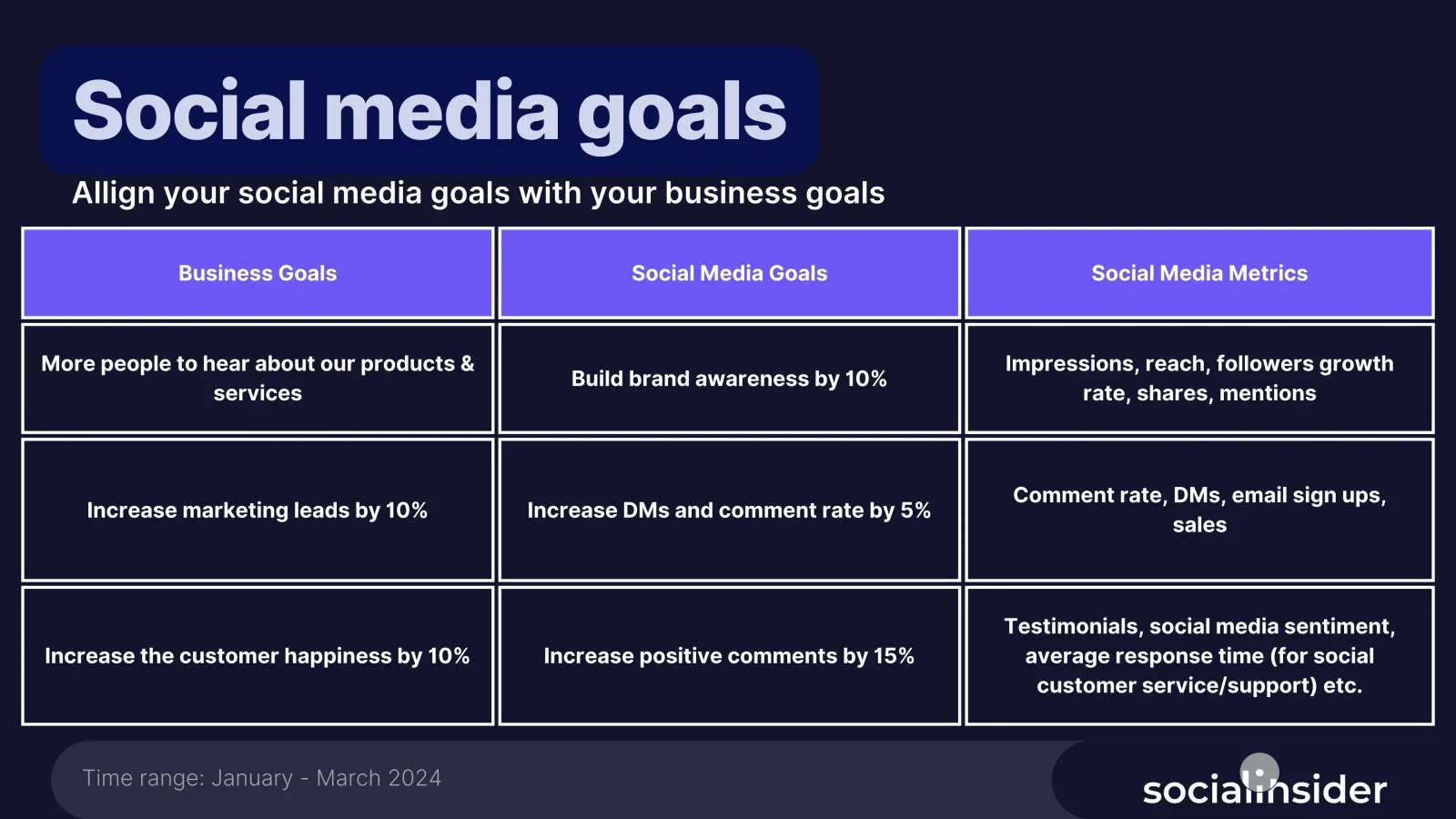
#2. Know your audience
The key to improving your social media engagement is understanding your audience and talking to them, not at them.
You can only create content that resonates deeply if you know your audience in and out.
Determine their interests, core pain points, and how they consume content. This allows you to speak the same language, ensuring your content feels relatable and tailored.
And just… Be social! To increase your social media engagement, keep the lines of communication open. Include clear calls to action to invite your audience to engage, such as asking them to share their thoughts, answer a question, or participate in a poll.
Most importantly, listen to what your audience says in response.
Engagement is a two-way street: if you encourage engagement, be sure to engage back.
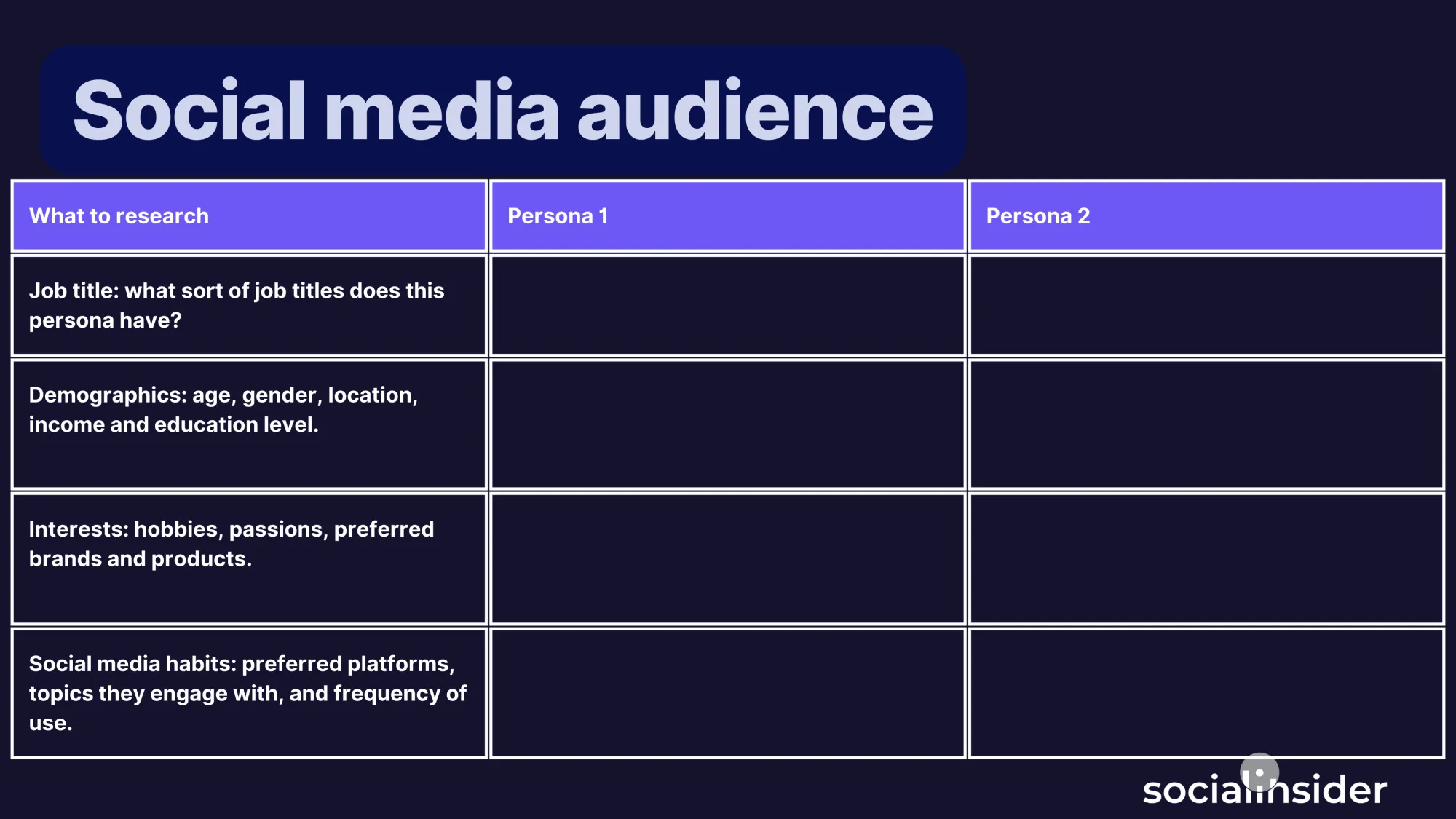
#3. Know the platform and the algorithm’s impact
Social media platforms prioritize different types of interactions and calculate engagement rates differently.
So, when you optimize your strategy for engagement, pay attention to the peculiarities of each social media platform.
For example, LinkedIn calculates engagement rates on posts using likes, comments, shares, clicks, and impressions, so every click on “see more” counts as a separate engagement. On the other hand, Instagram doesn’t consider clicks to be an engagement. Instead, it concentrates on likes, saves, comments, and shares.
Each platform’s algorithm assigns different “weights” to these engagement actions, influencing how content is displayed and prioritized in users’ feeds. Direct messages, replies, and story interactions count towards engagement numbers, but their impact can vary from social media platform to social media platform.
Here are the most “weighty” engagement metrics for major social media platforms:
- Facebook engagement favors lengthy comments and interactions on posts.
- Instagram engagement is heavily influenced by shares and saves that boost your visibility the most.
- LinkedIn engagement values content that generates meaningful interactions, such as comments and shares, over simple likes.
- TikTok engagement puts its trust into shares (also referred to as “reposts”) and completion rate (how much of your video is watched).
- Twitter engagement favors immediacy and relevance, but retweets and replies carry more weight.
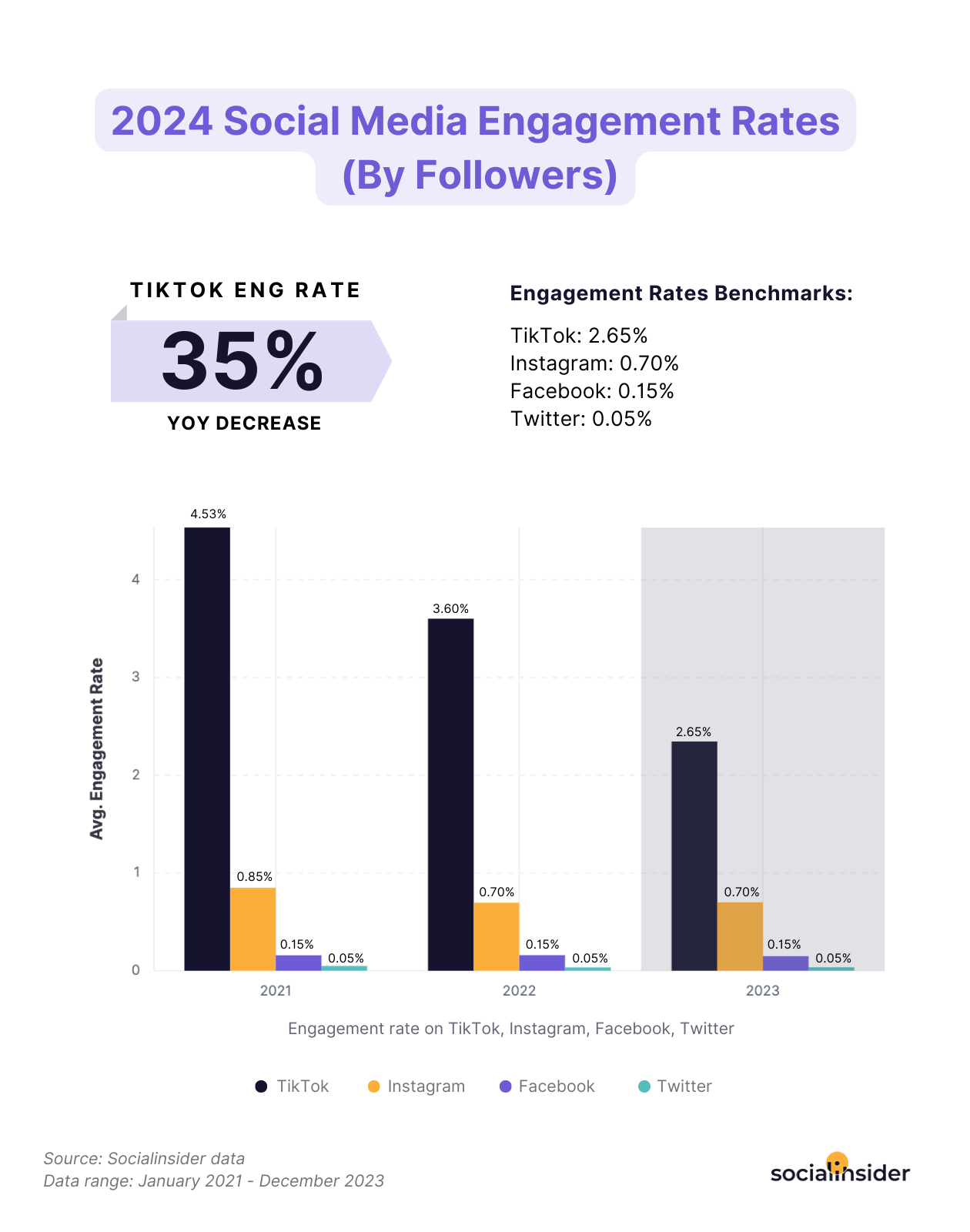
#4. Engage first
Social media engagement goes both ways, particularly on platforms like Instagram and LinkedIn, where how much you interact with other people’s content can really affect how much your posts get seen.
Jeremy Linaburg - Social Media Content Strategist & Community Builder - let us in on a cool social media engagement tip during his chat on the Socialinsider podcast. Before he posts anything, he spends 30 minutes interacting on the platform.
And we’re not talking mindless scrolling here — it’s about actively liking and commenting.
Before you even publish a post, your interactions within the platform can significantly impact how the algorithms rank your content for engagement and who sees it.
Proactive engagement tells the algorithms that you’re not just a broadcaster but a genuine part of the conversation.
This kind of warm-up act can dramatically boost your content visibility and improve your engagement overall by separating help queries from social media marketing efforts.
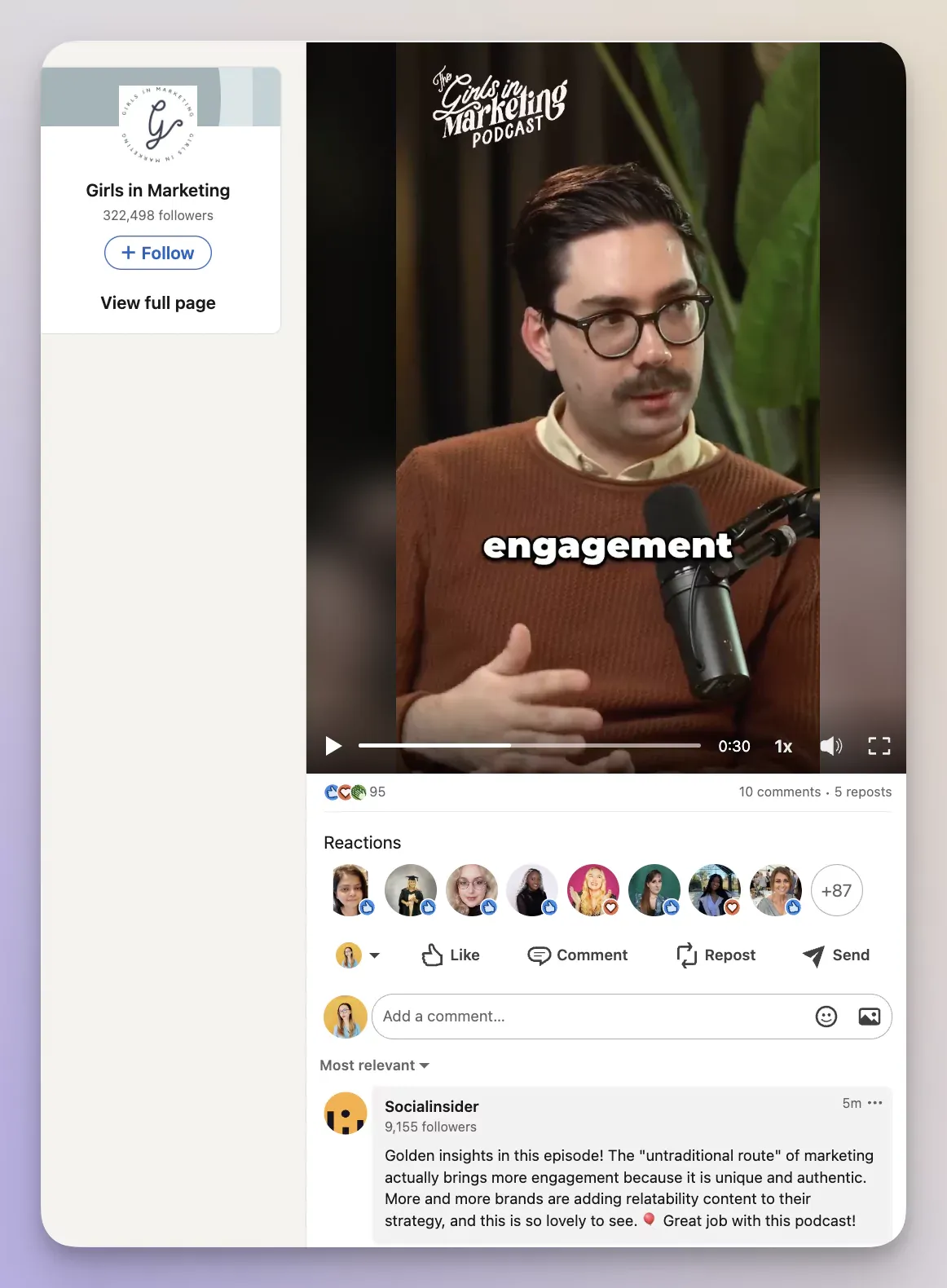
#5. Post consistently
When it comes to social media, consistency is key—more so than quantity. It’s better to post three times a week on a regular schedule than to post daily and then disappear for a week.
Social media algorithms favor users who are active and consistent. This helps keep your content in the loop and visible in your followers' feeds, preventing your engagement rate from dropping.
While there are general recommendations on how often to post on each platform, the real focus should be on how much high-quality content you can consistently produce.
It’s crucial to find a rhythm that works for you without compromising the quality of your posts.
So, if you can’t produce 3–4 videos for TikTok per day but can manage a solid daily one, go for it. Consistent quality and regular posting are way more important than quantity when it comes to sustainable engagement rates.
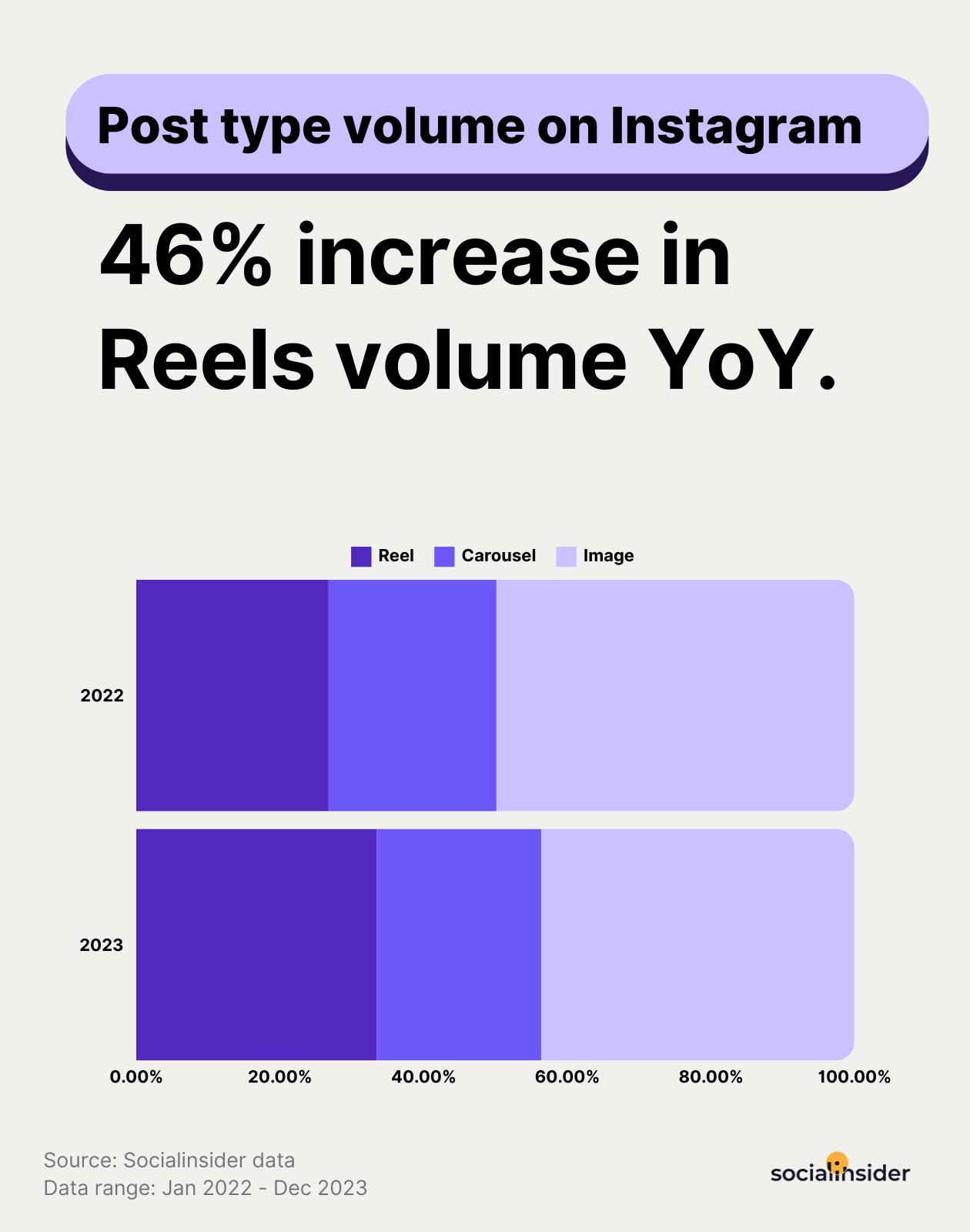
#6. Create social content
Among this year's social media best practices for increasing your engagement is the balance between business and social.
What grabs your attention more on platforms like Instagram or LinkedIn? A constant sales pitch or something that makes you laugh, think, or nod in agreement?
People don’t like to be sold things. They want to be entertained, educated, or amused — but not sold to.
Sure, hitting business goals is crucial. But if every post screams "buy this," you will most likely turn people off.
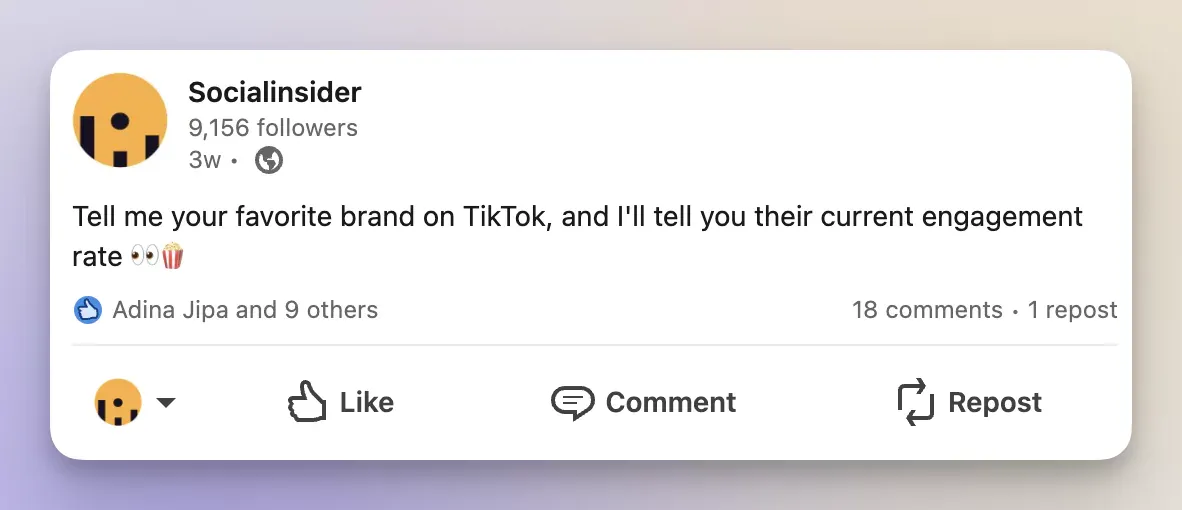
Great social media engagement examples among brands are Monzo, HubSpot, and Semrush. They mix up their feeds by throwing in memes, gifs, and fun social media engagement posts that feel personal, not just promotional.
By focusing on creating posts that educate or entertain, you'll naturally draw your audience closer, making those business goals more achievable without overwhelming people with sales pitches.
#7. Create interactive content
Encourage engagement not only through CTA but through content formats, too. Think polls, quizzes, and trivia that spark curiosity and invite participation.
Instagram has the most interactive tools for creating Stories. In addition to classic polls and action buttons, you can use “Add Yours” stickers to encourage story chains or design engaging templates that followers can fill out and repost.
Polls are also available on LinkedIn, TikTok, Facebook, Instagram, and X (Twitter). But don’t limit yourself to polls only: play with different reactions as voting options on LinkedIn and Facebook, or leverage dueting to create better content on TikTok.
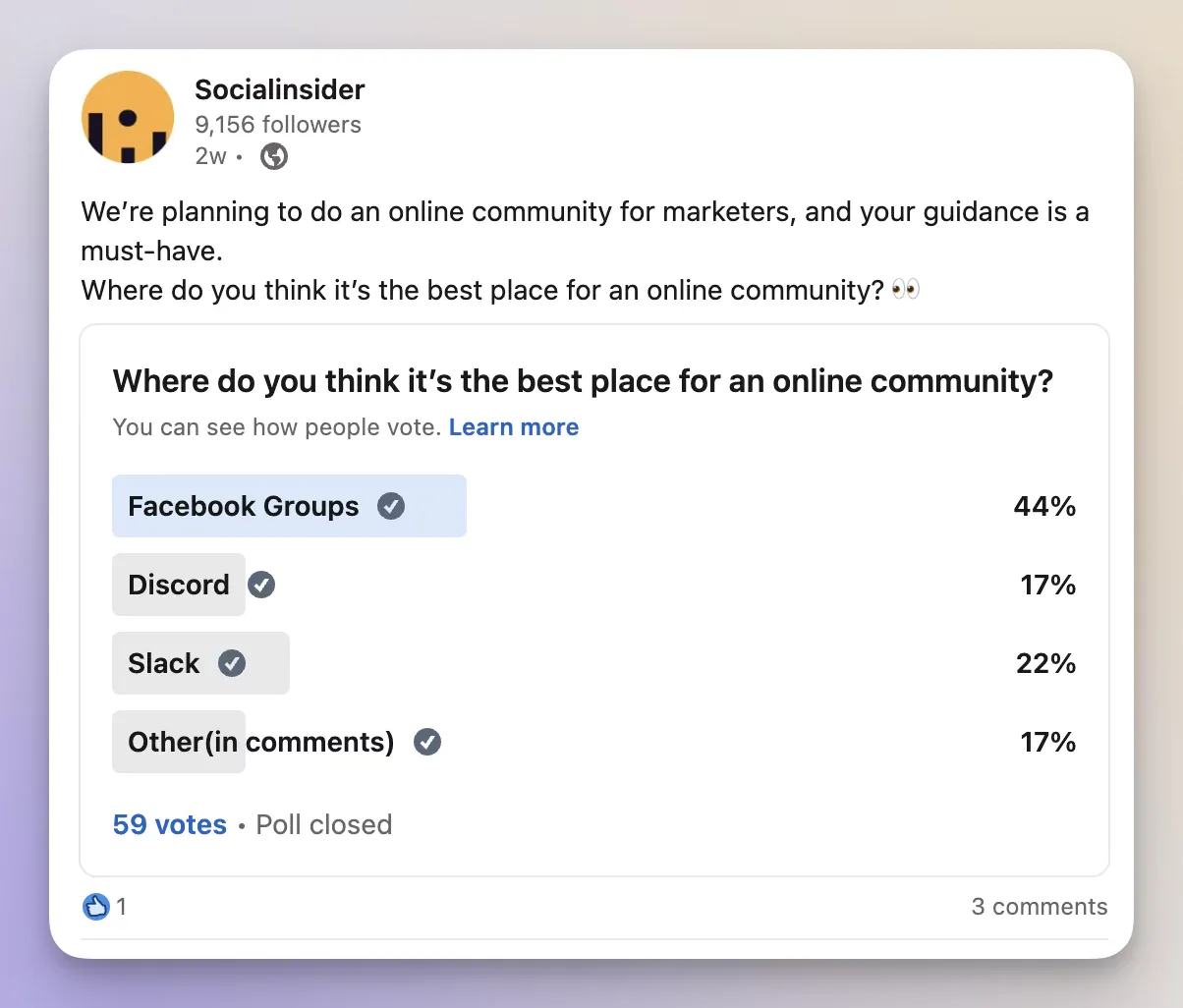
Such interactive elements help you increase engagement with your audience and include them in the conversation. This also helps you gather insights about your audience's preferences, enhancing your future content strategy.
#8. Create shareable content
If there’s one kind of content that can truly amplify your engagement rates alongside your reach on social media sites, it’s the kind people feel compelled to share.
Shareable content not only boosts your engagement rates but also naturally attracts more eyes to your account. Think about what makes content worth sharing — it often provides value, entertains, or sparks emotion.
One of the most effective content formats for boosting engagement is Reels. Instagram Reels are short, engaging videos that capture viewers' attention quickly and encourage interactions.
Due to their dynamic nature and prominent placement in social media algorithms, Reels often receive higher engagement rates compared to other content formats, as our Instagram benchmarks study confirmed.
You can also start creating Instagram carousels that lay out tips or ideas in a visually appealing way, videos that showcase your team or what goes on behind the scenes, or relatable memes that strike a chord within your industry.
Such content invites viewers to engage by sharing your posts with their network, essentially doing the heavy lifting of spreading your message.
#9. Comment bump
The comment bump is an interesting technique to boost engagement on social media posts. Any post has a lifespan, and this lifespan is pretty short in the sea of social media content. Posts quickly lose visibility as newer content floods in.
The comment bump helps you fool the algorithm in a totally lawful way by timing your responses to comments strategically.
After posting, it's crucial to let the post gather organic exposure. During the first critical 20 minutes, the algorithm assesses the post's engagement rate. Most user interactions happen during this phase.
But instead of responding to comments immediately, hold off until this initial flurry tones down. Start engaging with the comments approximately 20–30 minutes after posting.
This activity effectively "bumps" the post back into the news feed and triggers the algorithm to re-evaluate its engagement, potentially showing it to a broader audience.
#10. Use stories, short and live videos
Stories, short videos, and live videos are effective ways to increase engagement on social media.
Short-form videos don’t need additional introduction. They continue to dominate as the most engaging type of content across social media platforms, allowing brands to capture attention quickly and convey their message before the viewer moves on.
Stories allow for creative, fleeting interactions — think polls, quick tips, or flash sales — that keep your audience coming back for more. They are perfect for capturing quick, engaging content that doesn't clutter your main feed.
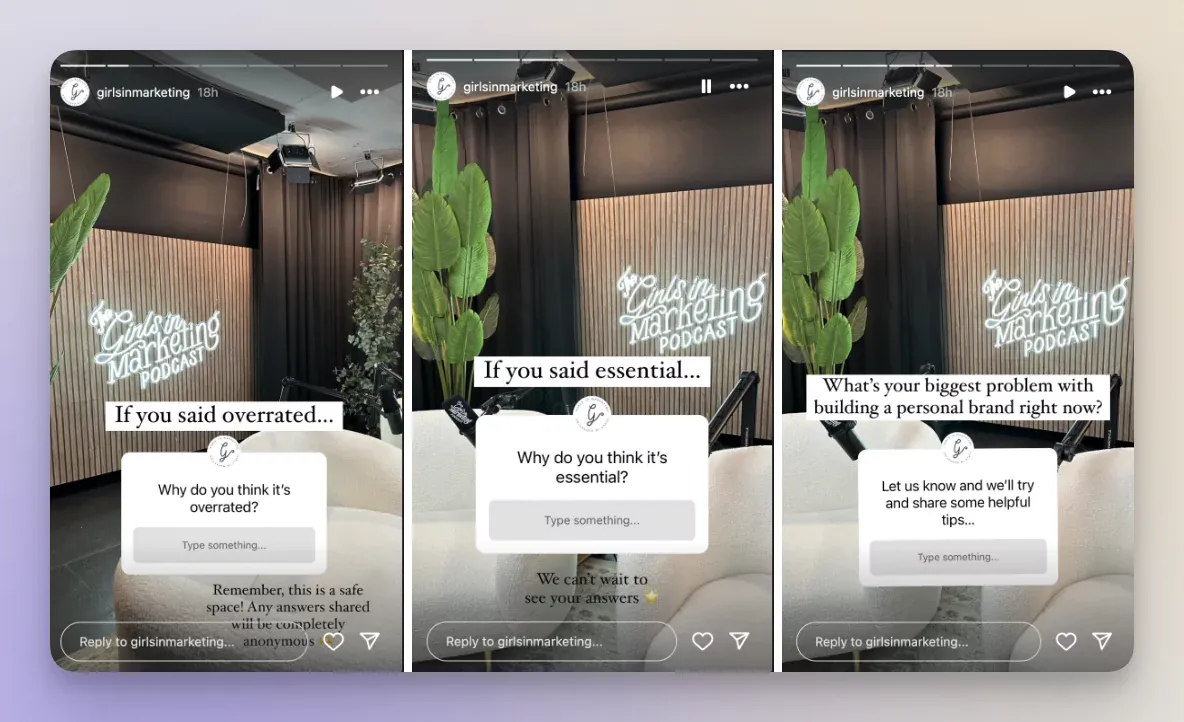
Live videos crank up the interaction to another level, offering real-time engagement. You can answer questions, showcase products, or just chat with your followers, making them feel a part of your brand's story.
Combining stories, shorts, and live videos adds a layer of authenticity and immediacy to your content, helping you reach a higher engagement rate.
#11. Create high-quality visuals
Over half of marketers (56.2%) believe high-quality visuals are key to their strategy, and it's easy to see why. Sharp images grab attention, stopping the scroll and drawing viewers into your content.
Carousels and multi-image posts let you flex those visuals with stories or collections that engage and invite shares.
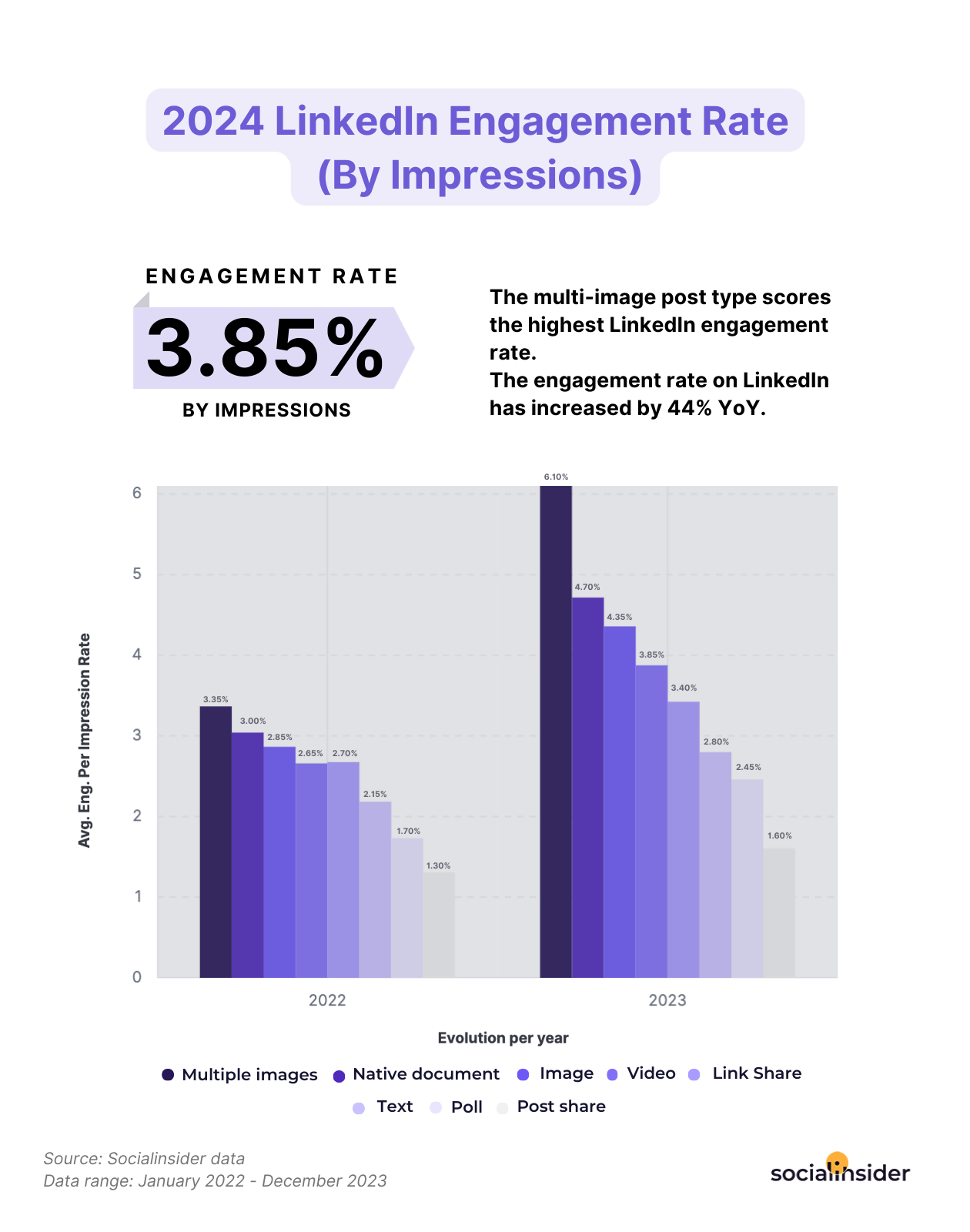
On LinkedIn, multi-image posts or detailed multi-page documents hold the crown for engagement. These formats allow deeper dives into your content, perfectly suited for the professional crowd looking for quality and depth.
High-quality visuals enhance your engagement efforts, so leverage them where possible.
#12. Bonus: Identify the most engaging content pillars
To boost engagement, knowing which social media content pillars resonate most with your audience is crucial.
Content pillars are your brand's key themes, like educational content, entertaining posts, or behind-the-scenes looks. Analyzing which ones engage the audience the most helps tailor your strategy for better results.
With Socialinsider, you can tag and analyze your posts based on these pillars. This feature reveals which types of content drive the most engagement, such as higher likes, shares, or comments.
For example, educational posts might perform best on LinkedIn, while a light-hearted and fun social media engagement post could thrive on Instagram.
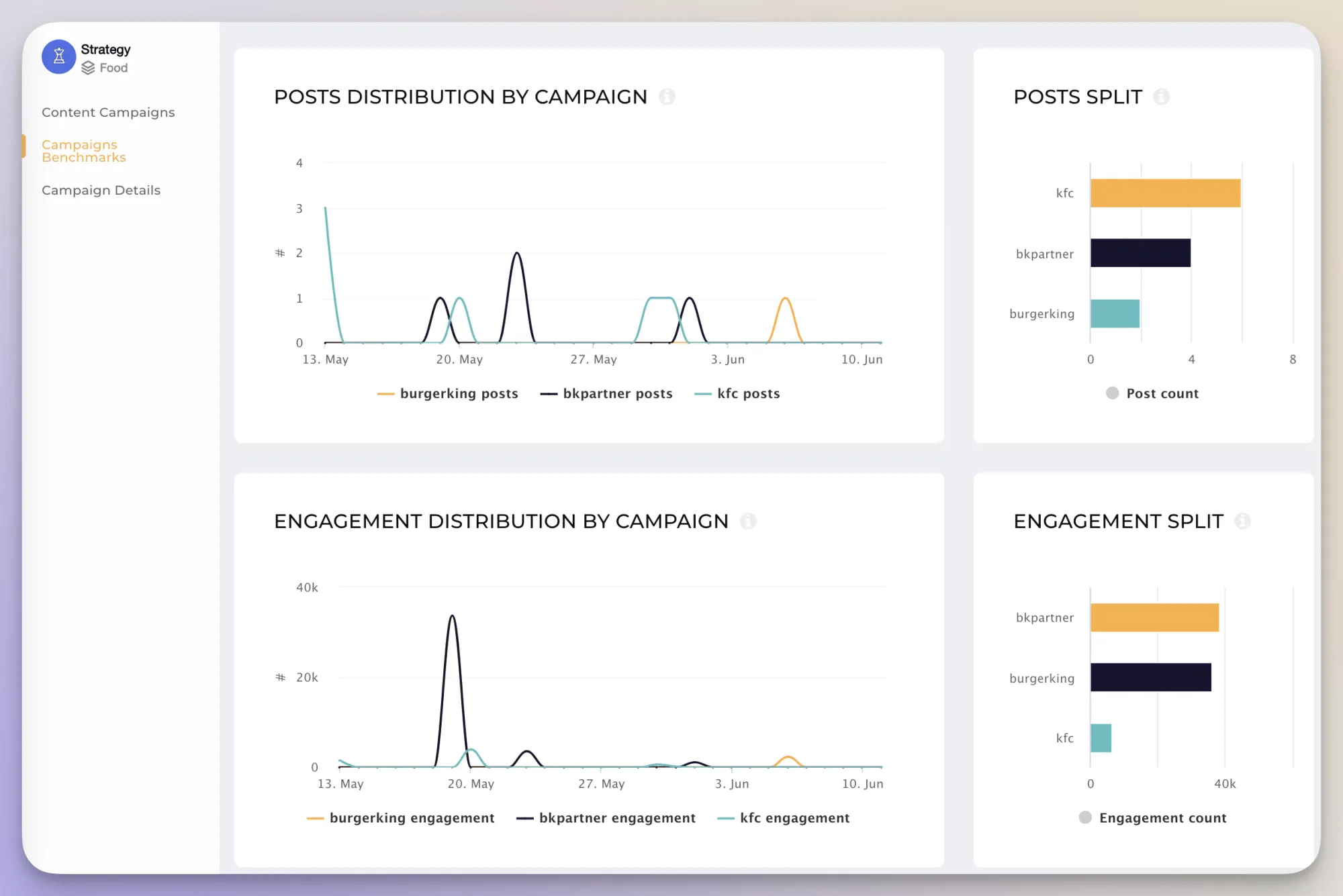
Socialinsider also lets you benchmark against competitors, providing insights into what works for them and how you can adapt those strategies.
How do you measure the impact of your social media engagement?
You can evaluate how engagement impacts your business by tracking several core metrics:
- Engagement rate. There are several formulas for calculating engagement rate using follower count, reach, or impressions. Socialinsider calculates the engagement rate as all post interactions divided by followers, reach or impressions (depending on social network) and multiplied by 100%. Engagement rate helps you gauge how actively your audience is involved with your content.
- Reach and impressions. Reach measures the number of unique users who see your post, while impressions track the number of times your post has been displayed. These metrics help you understand the extent of your content's visibility.
- Click-through rate. CTR is the percentage of people who clicked on a link in your post. This metric is crucial for evaluating the effectiveness of calls to action within your content, such as links to a website, blog post, or product page.
- Shares and brand mentions. We at Socialinsider monitor the number of shares and mentions to evaluate the success of our posts. For instance, research-based posts are always very engaging, driving many shares across social media.
- Video views and watch time. For platforms like YouTube, Instagram, and TikTok, tracking how many viewers watch your video content and how long they watch are important engagement indicators.
- Conversion rate. Measure how often users take desired actions (e.g., signing up for a newsletter or making a purchase) after engaging with your content. This ties social media efforts to tangible business outcomes.
Higher engagement on your posts and account gives you multiple advantages besides being favored by the algorithm. High engagement rates signal that you are building a community of active and involved followers who are more inclined to interact with your brand and convert into customers.
Another benefit of having an engaged audience is the direct dialogue. If your audience is not engaged, getting additional insights like their preferences, wishes, and pain points is much harder. When you have an established connection with your customers, you are more likely to get more answers from them.
For instance, comments on your posts can be a gold mine of insights about your followers. We use comments to find new ideas for posts and test our hypotheses all the time!
Final thoughts
Social media engagement is more than just likes and shares; it's about fostering meaningful interactions and building a community around your brand. By understanding your audience, creating relevant content, and utilizing analytics, you can enhance your engagement strategies.
Experiment with different types of content, stay updated with platform changes and be consistent in your efforts.
Social media is dynamic, and staying engaged requires continuous effort and innovation. Embrace these strategies, and you'll see your engagement metrics improve significantly over time.
FAQs about social media engagement
Why is engagement so crucial?
Social media engagement is crucial because it signifies that your audience is not just seeing your content but interacting with it. This interaction demonstrates an interest and connection to your brand, whether it's likes, comments, shares, or saves.
High engagement increases your visibility on social media platforms because algorithms tend to favor highly engaging content. It also enhances brand loyalty and improves conversion rates, as more engaged audiences are more likely to act on your calls to action.
What is the key to social media engagement?
The key to social media engagement is consistently providing value in a way that resonates with your audience.
It can be informative posts, entertaining content, or interactive activities like polls and quizzes. Understanding your audience’s needs and preferences and tailoring your content to meet those needs skyrockets engagement rates.
Engaging directly with your audience by responding to comments and messages also fosters a stronger relationship and encourages more interaction.
How to measure social media engagement?
To measure social media engagement effectively, track interactions at both the account and post levels:
- Account-level engagement provides an overview of total engagement activities across all posts during a specific period, helping gauge overall performance.
- Post-level engagement focuses on specific interactions per post, offering detailed insights into what content resonates best with your audience.
What is the maximum engagement level that a brand can reach?
There is no maximum level of engagement for a brand on social media. The sky’s the limit!
However, there are industry-wide benchmarks for each social media platform that you should keep in mind to build your strategy and evaluate results. You can find general social media benchmarks in Socialinsider's report.
Or, if you want to really rock your strategy, use Socialinsider's competitor analysis tool. It allows you to monitor your closest competitors’ metrics (including their engagement rates) and benchmark your performance against those who matter to you in your niche.







